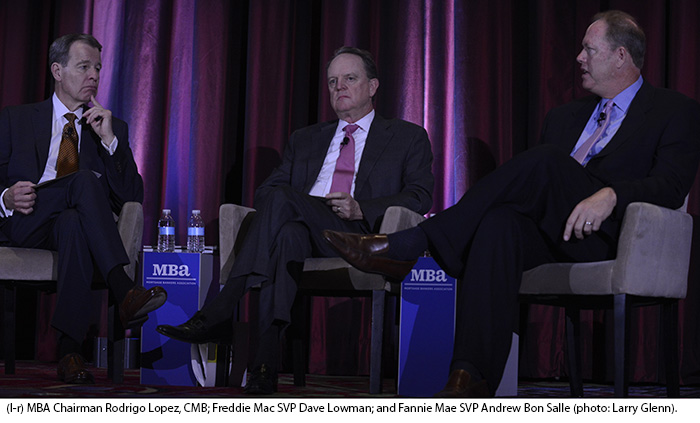
GSE Execs Cite Origination Declines, but ‘Robust’ Business Environment
NEW YORK–Senior officials from Fannie Mae and Freddie Mac offered a cautiously optimistic forecast for the secondary mortgage market in the near future, despite projected declines in volume.
“Our forecast for this year is to be down by about 20 percent on total volume,” said Andrew Bon Salle, executive vice president of single-family business with Fannie Mae, Washington, D.C. “The shift is happening. We’re seeing a sharp drop in refinance applications, but we’re seeing a stronger uptick in the purchase market.”
 “We continue to have a robust business environment,” said Dave Lowman, executive vice president of single-family business with Freddie Mac, McLean, Va. “We’ve seen the mix of purchase and refi hanging in there, with refis slowly choking off. Volumes are down, but rates are down and this is still a great time for people to borrow. We do expect a drop in overall volume by about 25 percent, from $2.1 trillion in 2016 to about $1.5 trillion this year.”
“We continue to have a robust business environment,” said Dave Lowman, executive vice president of single-family business with Freddie Mac, McLean, Va. “We’ve seen the mix of purchase and refi hanging in there, with refis slowly choking off. Volumes are down, but rates are down and this is still a great time for people to borrow. We do expect a drop in overall volume by about 25 percent, from $2.1 trillion in 2016 to about $1.5 trillion this year.”
Speaking here at the MBA National Secondary Market Conference & Expo, Lowman noted inventories of homes remain tight. “Theoretically there are more buyers out there than there are homes,” he said.
“All eyes are on interest rates,” Bon Salle said. “You have a potential for a flight to quality that could push down rates. And depending on consumers’ attitudes toward the current Administration and the ability of Congress to move forward, you could see a drop in confidence…The lack of supply is a challenge for first-time homebuyers, and zoning issues and lack of space could continue to have an effect on inventory.”
“Liquidity continues to be a problem in the mortgage servicing rights environment,” Lowman said.
Both executives noted efficiencies have increased substantially, driven by the GSEs themselves and demand from lenders and home buyers.
“What we hear is that our customers want solutions that help them do better business,” Bon Salle said. “They want certainty in the marketplace, and they want to enable a better borrower experience around a digital standpoint, which excites me. We are working with our vendors to make that happen.”
Fannie Mae’s Day 1 Certainty program has been a “game-changer” for the industry, Bon Salle said. “We’ve heard anecdotally that for some of our customers it’s cut the process in half. We’re also working with our servicers to increase efficiency and we’re working hard on managing credit risk. We have a pretty wide box–a 620 FICO minimum. So the next step is extending that box to borrowers. It’s not surprising that most of our business has been right down the middle, but we hope that Day 1 Certainty will generate some confidence in the market and expand the box.”
“We sit on an unbelievable amount of data,” Lowman noted. “We are trying to fundamentally re-imagine the mortgage process. It’s manifested itself in development of our Loan Advisor suite, in which we marry up data that’s publicly available with our own data and lender input.”
The Federal Housing Financial Agency recently issued a report on the GSEs’ Common Securitization Platform and the Single Security, developed with a company jointly owned by Freddie Mac and Fannie Mae. The first phase of the CSP launched last November. Both projects continue to move forward, Bon Salle and Lowman said.
“It went well,” Lowman said. “Both teams are working together to get the next phase ready by 2019. It seems like a long way from now, but there is a lot of work, a lot of coordination and a lot of testing that remains to be done. It’s a massive project–it would be huge for a single company, but for three companies working on that, it takes on a whole new aspect.”
Fannie Mae also moved its next phase back to 2019. “Our main focus is ensuring that the TBD markets continue to operate efficiently,” Bon Salle said. “We’ve already made changes to our investor reporting timeframes to February, which went well. We’re in pretty good shape, but a lot of testing remains to be done.
Lowman said credit risk transfer continues to be a priority. “We continue to work toward redistributing the risk that we’ve accumulated,” he said. “We’re redistributing this risk globally as well as domestically. At the end of the day we are setting standards and distributing risk in a scalable way. We need to make sure that we never end up in the position we were in before where we had so much exposure.”
“It’s the way to do business now,” Bon Salle said. “We now distribute risk on about 25 percent of our book. We’ve created a whole suite of execution and tools to meet the needs of our customers…we also have programs for lenders who want to own their own risk. This is how we are going to do business going forward and we hope that it will result in some private capital coming back into the market. We’ve made a lot of progress in a very short time.”
